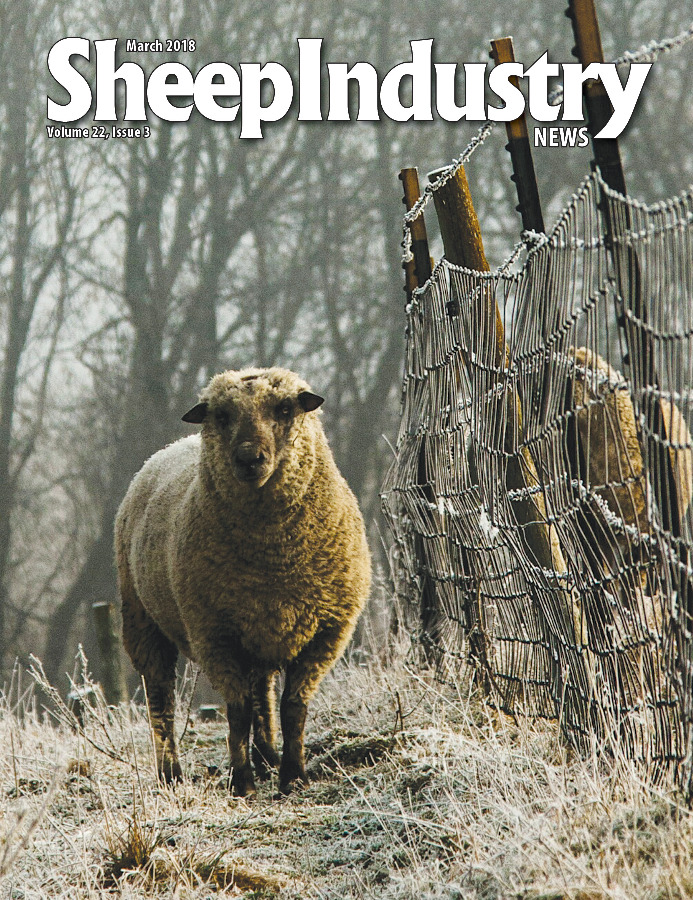
- March 2018
- President’s Notes
- Jerry King Cartoon
- Convention: Sheep Producers Share Concerns with USDA
- Convention: Industry Leaders Recognized
- Convention: MIWW Celebrates 70 Years
- Convention: American Wool Uses Technology
- Convention: Nourish With Lamb Spreads Message
- Convention: PERC Discusses Possible FMD Outbreak
- Convention: Kangols Top Guard Dog Breed
- Convention: Genetic Stakeholders Understand Value of Data
- Convention: Sheep Disease Updates
- Convention: Resource Management Eyes Progress
- Convention: Young Entrepreneurs
- Electronic Grading Approved at Superior Farms
- ALB Picks Denver as Next Target Market
- Wool is Popular at Outdoor Show
- Sheep Inventory Flat in 2017
- Feedlot Report Available
- Young Entrepreneur: Jake Kerr
- Sec. Perdue Names ALB Appointees
- Three Appointed to Sheep Center
- Around the States
- Market Report
- The Last Word
PERC Discusses Effects of Possible FMD Outbreak in United States
CAT URBIGKIT
The Shepherd
Foot and mouth disease is an extremely infectious virus, requiring as few as 10 virus particles to infect an animal, according to Dr. Mark Thurmond of the University of California-Davis.
“It’s considered the most infectious agent that we know of in any animal, including humans,” he told the Production, Education and Research Council. He added that FMD produces massive amounts of cell destruction and cell infection, and can survive in the environment for months (on footwear, tires, etc.).
In sheep, FMD “shows signs that typically you will not see,” meaning that the symptoms, if any, are subtle. An animal might go off feed for a few hours, or experience diarrhea or lameness.
The massive FMD epidemic in the United Kingdom in 2001 was widespread because sheep – which were being transported across the region – were carrying FMD and spreading the infection.
“This is particularly worrisome for the United States sheep industry because it’s going to be a silent infection,” Thurmond said.
Diagnosis will take some time, and then quarantine begins after the first diagnosis. But it’s likely FMD will have had several weeks or months to spread unchecked before that first diagnosis.
“Do you stop all movement in the state?” Thurmond questioned. “Will it stop business completely?”
Thurmond suggested FMD must be stopped it in a way that doesn’t wipe out the livestock industry in the process. “We face a dilemma here,” he said.
In addition to the challenge of dealing with an infectious virus, the United States has a rapid system for moving animals and animal products, Thurmond said, so animal health officials are moving forward with developing contingency plans for FMD control. Part of that planning effort will be to conduct regional studies of domestic animal movements and culling practices to examine what regions are at higher or lower risks. The goal is to identify weak and strong points to develop an action plan for control.
Thurmond said planners must address a variety of questions:
• What kinds of movements can be changed to not disrupt the food supply?
• Should there be an outbreak in Kansas, what will that mean in California?
Thurmond added that less than 2 percent of imports going through our ports of entry are inspected.
“We probably have it sitting there,” Thurmond said. “It probably just hasn’t gotten into the animal chain yet.”
Thurmond also talked about Rift Valley Fever, a mosquito-born virus originating in Africa that is infectious to humans through handling infected animals. In animals, it’s an acute disease that will kill animals through hemorrhagic disease, and can cause waves of abortion in sheep and goats.
The regional risk assessment survey will aid in developing ideas for risks, as planners assess the educational understanding of these diseases (are producers well aware of the disease?), as well as learn what kind of animal movement occurs in the region (to and from, what time of year, etc.). The collection of this information will allow planners to map out areas where there is a potential for high risk, so mitigation measures can be identified.
Questions to be answered at the regional level include:
• What percentage of lambs are sent directly to a feed yard?
• What percentage of shipments to slaughter are sent out of region?
• What months are busiest for shipment of breeding stock?
• What percentage of breeding stock are migratory?
Audience members noted that proposed federal transportation rules would require more frequent off-loading of livestock that are being trucked, causing the risk of disease transmission to worsen, to which Thurmond agreed.

